Lately I’ve been having a lot of conversations around investment terms with searchers, as well as investors.
About 15 years ago, I interned at a search fund. And, over the last few years, I’ve started to invest in the asset class going direct as well as through funds of search funds.
Investing in search funds is a great way to scratch my entrepreneurial itch, extremely rewarding when a searcher finds success, and can be economically rewarding too.
This post is my attempt to share thoughts on self funded search economics in an effort to contribute to the search fund community, get feedback on my thinking from a wider audience, and of course meet more people who are doing searches/investing and may want to collaborate (please feel free to reach out!).
You can watch a video of me explaining this model here, and download the excel here:

Enterprise Value
The standard finance equation is enterprise value = debt + stock – cash. Enterprise value is how much the company itself is worth. Many times people confuse it with how much the stock is worth and find the “minus cash” part of this really confusing.
So, you can rearrange this equation to make it stock = enterprise value – debt + cash. Make more sense now?
Enterprise value is just how much you’re willing to pay for the company (future cash flows, intellectual property, etc), not the balance sheet (debt and cash).
Most investors and searchers think about the EBITDA multiple of a company on an enterprise value basis because they’ll be buying it on a cash free, debt free basis. It becomes second nature to think about EBITDA multiples and know where a given business should fall given scale, industry, etc.
However, I believe this second nature way of thinking of things can be a massive disadvantage to investors given the way EV and multiples are talked about in our community currently.
Sources of capital, the typical way to calculate enterprise value for self funded searchers
If you’ve ever looked at or put together a teaser for a self funded search deal, you will notice that the deal value is equal to the sum of the sources of capital minus deal fees and cash to the balance sheet.
As a simple example, if there is $4 mm of debt to fund the deal, $1 mm of equity, and $200k of deal fees, the enterprise value = $4 mm + $1 mm – 200k = $4.8 mm.
We’ll use slightly more complex numbers in our example: If a searcher is taking a $3.2 mm SBA loan, $850k seller note, putting in $120k themselves, getting $350k of equity from the seller, a $500k earnout, and $1.2 mm of equity financing minus $350k to the balance sheet and $250k of deal fees, then the enterprise value will be $5.62 mm.
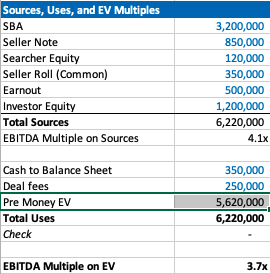
Our example company has $1.5 mm of EBITDA, so the EBITDA multiple is 3.7x. This is a pretty attractive acquisition multiple for a business that meets traditional search criteria (recurring revenues, fragmented competition, high gross margins, low customer concentration, etc).
If you’re seeing a search fund deal for the first time, the headline of “we’re buying a decent company for 3.7x, and replacing a tired owner with a hungry operator” is pretty exciting!
However, if you’re an investor, there is some nuance to this enterprise value number and the true EBITDA multiple you are investing in.
The trick with self funded enterprise value
The security that most self funded search investors get in a deal is participating preferred stock with a paid in kind dividend. This means when there’s an exit, you get your money back before any other equity holder, then get a certain percent of the business, and whatever dividend you’ve been owed in the interim accrues to your principle.
It’s a really favorable security for the investor, and one that is basically impossible to get in VC where straight preferred stock is much more common (no pun intended).
The key terms are what percent of common equity does this security convert into after the originally principal is paid back, and what is the dividend.
The share of common equity the investor group will get typically ranges from 10-50% of the total common stock. The dividend rate is usually 3-15%. The average I’m seeing now is around 30% and 10% for common and dividends respectively.
The strange this about the enterprise value quoted to investors in a teaser/CIM is that it doesn’t change as the percent of common changes, even though this has large implications for how much the common equity is worth and the value investors receive.
For example, I may get a teaser where the sources of investment – cash to balance sheet – deal fees = $3.7 mm for a $1 mm EBITDA company, which would imply a 3.7X EBITDA multiple. Let’s say the searcher is offering investors 30% of the common and a 10% dividend.
Let’s now say that the searcher is having a tough time raising capital and changes their terms to 35% of common and a 12% dividend. Does the effective enterprise value change for investors? I would argue yes, but I would be surprised to see it changed in the CIM/teaser.
This isn’t a knock on searchers or the search fund community. It’s just kind of how things are done, and I think this is mostly because it’s really hard to think about how the enterprise value has changed in this scenario.
However, the natural way of using EBITDA multiples to think about value for a business that is so common in PE/SMB can be extremely misleading for investors here. You may be thinking 3.7X for this type of business is a great deal! But, what if the security you’re buying gets 5% of the common?
If you’re in our world, you may counter this point by saying most searchers will also supply a projected IRR for investors in their CIM. However, IRR is extremely sensitive to growth rate, margin expansion, and terminal value. While the attractiveness of the security will be reflected, it can be greatly overshadowed by lofty expectations.
To get more clarity and have a slightly different mental model on the effective price investors are paying for this business, let’s go back to basics. Enterprise value should be debt + preferred stock + common stock – cash.
We know the values of each of these numbers, except the common. So, the main question here becomes: how much is the common equity worth?
Calculating value of common equity for self funded search funds
Equity value for most search fund deals = preferred equity from investors + the common equity set aside for the searcher and sometimes also advisors, board, seller.
We know that the preferred equity is investing a certain amount for a certain amount of common equity. The rub is that they are also getting a preference that they can take out before any common equity gets proceeds, and they are getting a dividend.
So, the exercise of valuing the common equity comes down to valuing the preference and dividend.
In my mind, there are three approaches:
- The discount rate method where you take the cash flows you’ll get in the future from the pref/dividends and discount them back at the discount rate of your choice. I am using 30% in my model which I believe accurately compensates investors for the risks they are taking in a small, highly leveraged investment run by an unproven operator. If you believe in efficient markets, this number also fits as it mirrors the historical equity returns as reported by the Stanford report, with a slight discount given this asset class has clearly generated excess returns relative to other assets on a risk adjusted basis, hence interest in these opportunities from an expanding universe of investors.
- The second method is to calculate how much money you’d get from your preference and dividends, taking into account that per the Stanford study around 75% of search funds will be able to pay these sums, and then discount these cash flows back at a rate more in line with public equities (7% in my model). This yields a much higher value to the preference/dividend combo, and therefore lowers the implied value of the common equity.
- The last method is to just say nope, there is no value to the preference and dividend. I need them and require them as an investor, but they are a deal breaker for me if they aren’t there, and therefore they don’t exist in my math. This of course makes no logical sense (you need them, but they also have no value?), but I’ve left it in as I think many investors probably actually think this way and it creates a nice upper bound on the enterprise value. Side note, as with obstinate sellers, jerk investors are usually best avoided.
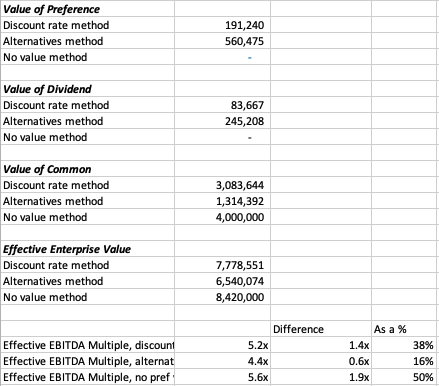
In our example, you can see a breakdown of the preference value, dividend value, and therefore common value and enterprise value for this deal.
In each case, the effective EBITDA multiple moves from 3.7x to something much higher (see the last 3 lines).
There are some simplifying assumptions in the model (no accruing dividend, all paid in last year), and some weird stuff that can happen (if you make the hold time long and the dividend greater than the 7% equity discount rate, the value of the dividend can get really big).
These flaws aside, I think this creates a nice framework to think through what the common is actually worth at close, and therefore what enterprise value investors will be paying in actuality.
It’s worth noting that the whole point of this is to benchmark the value you’re getting relative to market transactions in order to understand where you want to deploy your capital.
This creates a method to translate cash flow or EBITDA multiples of other opportunities on an apples to apples basis (if only there were a magical way to translate the risk associated with each as well!).
Another note, we could calculate the value of the common to be what this asset would trade at market today in a well run auction process minus any obligations (debt, preference, seller financing). However, I think that understates the option value inherent in this equity, a value that is only realized when a new manager takes over with more energy and know how.
There is a finance nerd rational for this. If you plot the value of equity in a leveraged company on a chart, it mirrors the payout of a call option. In both cases, the value of the security increases at a certain inflection point: when the value of equity rises above the strike price in an option, and when the enterprise value of a company rises above the debt level in a levered company.
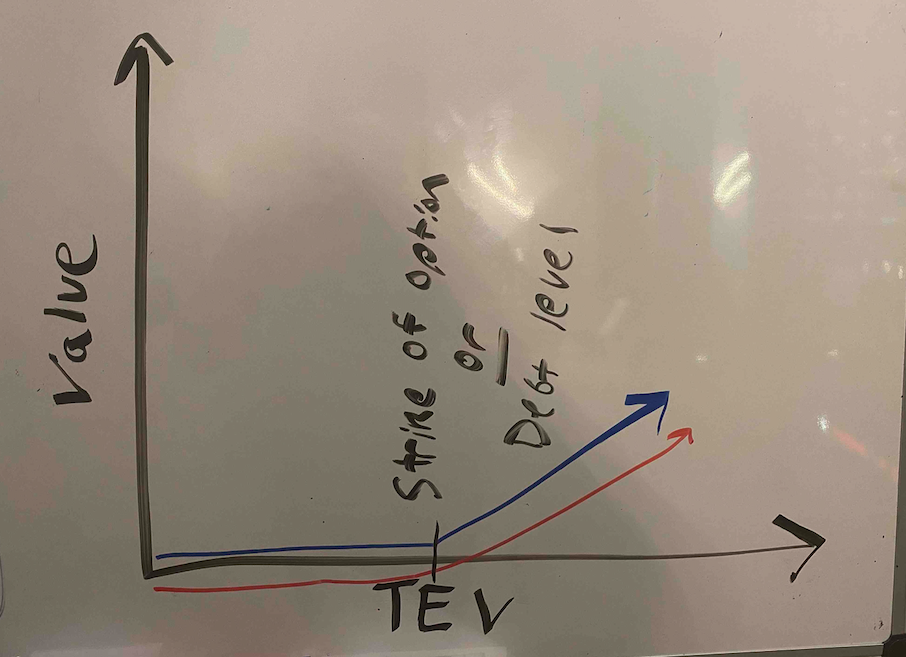
The common equity of a highly levered company can therefore be valued by a similar methodology as the call option: Black Scholes. If you remember back to finance class, increasing volatility will increase the value of an option.
In the search fund case, we’ve (hopefully) increased the (upside) volatility and therefore create more value than simply selling the company today.
A few more thoughts on investor economics
There are a few other ways to think about the economics you get as an investor to best understand if this is the deal for you.
First, you may want to think about how much your investment will be worth day 1. The key lever in this model is what discount this company is being bought for relative to fair market value. For example, the searcher may have proprietary sourced a great company and is buying it for 25% below what it would trade at in a brokered auction.
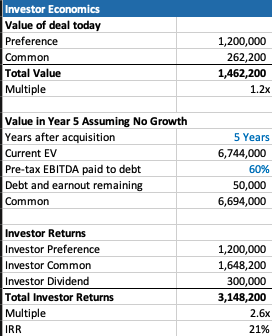
This is very much a “margin of safety” philosophy on things. Same with the calculation on how much you’ll receive in year 5 (after QSBS hits) assuming no growth in the business.
The only problem with each of these calculations is that they never play out in practice. Most companies don’t just stay the same, you’re either in a rising tide or you’re in trouble. And, you’re almost never going to sell in year 1, and definitely not for a slight premium to what it was bought for.
However, if your investment is worth 30% higher day one, and you can make a 20% IRR assuming nothing too crazy happens either way in the business, that’s not a bad place to start. Add in a strong searcher, decent market, some luck, and you’re off to the races.
Thoughts on searcher economics
A lot of this post has considered things from the investor perspective as my main quandary was related to how to create an EBITDA multiple that made sense for investors.
However, the point of this post is not to say searchers are misrepresenting or being unrealistic with their terms. In fact, I think it’s quite logical that self funded searchers capture the massive economic value that they do.
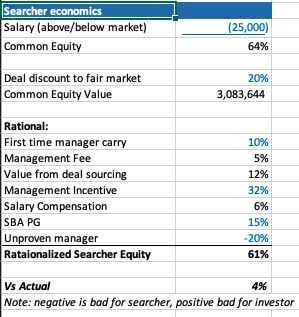
There are many reasons why self funded searchers deserve the lion share of the common equity.
First, they are providing a nice service of giving investors a positive expected value home to park their money with much lower correlation to the market than other asset classes ($1 mm EBITDA companies don’t see lots of multiple contraction/expansion throughout cycles).
Most money managers that fit that criteria are taking a 2/20, of course they also usually have a track record. So, I’ve used a 10% carry in my model, but stuck to 2% annual management fee.
The searcher spent a lot of time, and probably money, finding this company. That’s a lot of value, especially if it’s a below market price. They should be able to capture a lot of the value in finding a below market deal.
The searcher may be taking a below market salary, and needs to get comped like any CEO, with stock options. In my example model I have $1 mm of stock vesting over the hold period, as well as extra comp for taking a below market salary.
Searchers are also usually putting their financial standing at risk by taking a personal guarantee on the bank/SBA loan. This is really tough to put a number on, as is the last line in my framework where searchers are dinged for lack of experience. Like any good model, you need a few lines that you can fudge to make the math work 🙂
What you do think?
I’m shocked that I wrote all this. I was going to type a few paragraphs and a quick excel. However, putting this to paper has been a great exercise for me to sharpen my thinking.
Now I’d like you to help me further. Where do you think this should be changed in this framework? How do you think about things from the investor and/or searcher side?
Feel free to shoot me a note if you have thoughts (even just to tell me I’m being way too academic with this, which I actually agree with).
Lastly, a post like this is really a trap I’m putting on the internet to catch any like minded people in so that we can figure out ways to collaborate now or in the future. So, at the very least, connect with me on LinkedIn 🙂
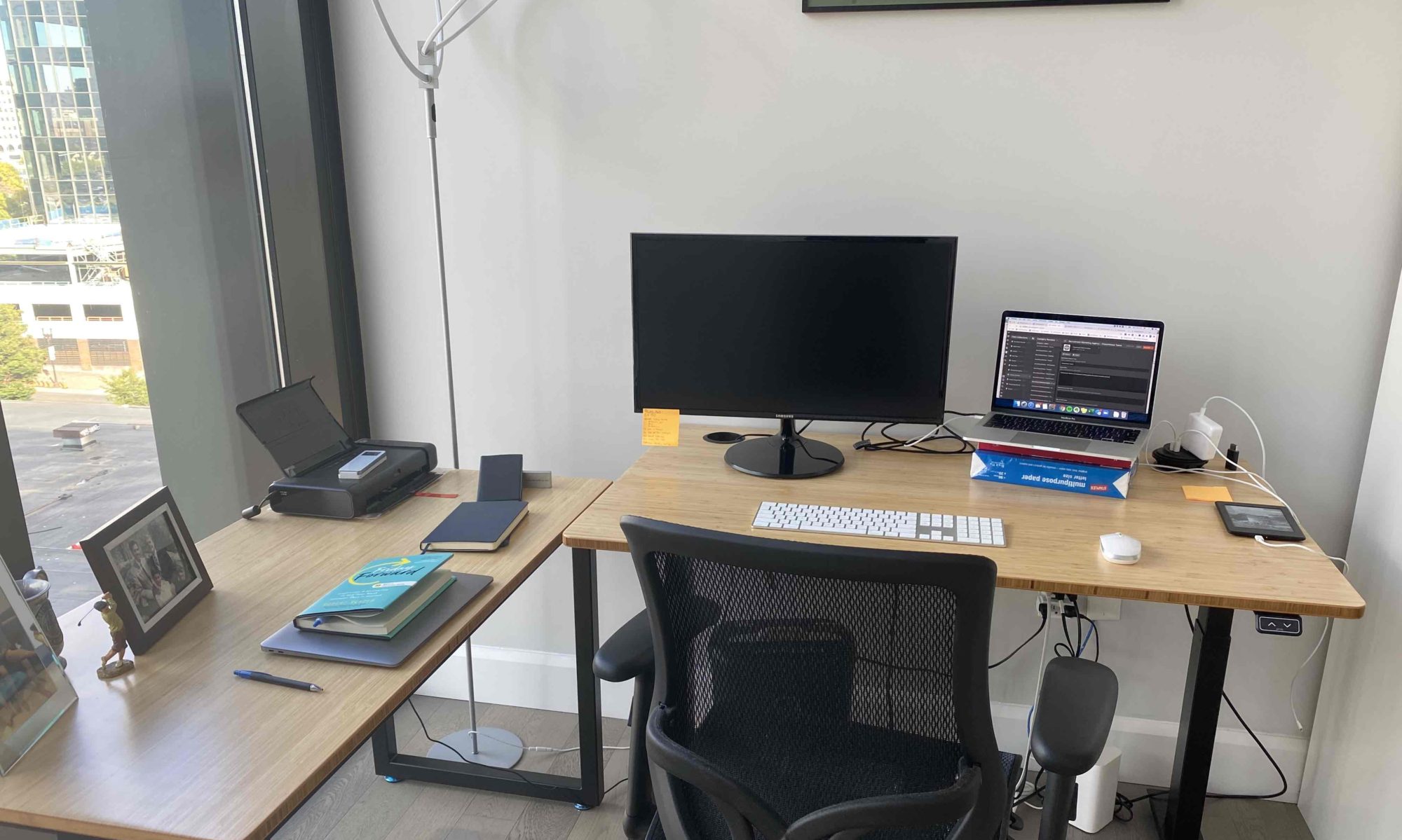
I was recommended this web site via my cousin. I am not sure whether
this submit is written through him as nobody else recognize such
unique about my trouble. You are amazing! Thanks!
You really make it seem so easy with your presentation but I find this topic to be
actually something that I think I would never understand.
It seems too complicated and very broad for me. I’m looking forward for your next
post, I’ll try to get the hang of it!
Simply wish to say your article is as surprising.
The clarity in your post is simply cool and i can assume you are an expert on this
subject. Fine with your permission let me to grab your RSS feed to keep up to date
with forthcoming post. Thanks a million and please
carry on the rewarding work.
Link exchange is nothing else except it is simply placing the other person’s
weblog link on your page at proper place and
other person will also do same in favor of you.
I feel that is among the most vital info for me.
And i am satisfied reading your article. But wanna
remark on few general things, The website taste is great, the articles is in point of fact nice :
D. Excellent task, cheers
Fantastic website you have here but I was wanting to know if
you knew of any message boards that cover the same topics talked about in this
article? I’d really love to be a part of online community where I can get
responses from other knowledgeable individuals that share the same interest.
If you have any suggestions, please let me know.
Thanks a lot!
Howdy I am so grateful I found your site, I really found you by
accident, while I was researching on Askjeeve for
something else, Anyways I am here now and would just like to say thanks for a incredible post and a all round interesting blog (I also
love the theme/design), I don’t have time to browse it all at the minute but I have book-marked
it and also added in your RSS feeds, so when I have time I will be back to read more, Please do
keep up the superb jo.
Thanks a bunch for sharing this with all folks you really realize what you are speaking approximately!
Bookmarked. Please also seek advice from my web site =).
We can have a link alternate agreement between us
Thank you a bunch for sharing this with all folks you actually know what you are talking
approximately! Bookmarked. Please also discuss with my web site =).
We can have a hyperlink change contract between us
Thanks for sharing your thoughts on daftar bandar
slot android. Regards
Hi! Someone in my Myspace group shared this site with us so I came to check
it out. I’m definitely enjoying the information. I’m bookmarking and will
be tweeting this to my followers! Wonderful blog and
terrific design and style.
hi!,I like your writing very so much! share we be in contact more approximately
your article on AOL? I need an expert on this house to solve
my problem. Maybe that’s you! Taking a look forward to look you.
My coder is trying to convince me to move to .net from PHP.
I have always disliked the idea because of the costs. But he’s tryiong none the less.
I’ve been using Movable-type on numerous websites for about a year and am nervous about switching to another platform.
I have heard excellent things about blogengine.net.
Is there a way I can transfer all my wordpress content into
it? Any kind of help would be really appreciated!
Simply want to say your article is as surprising. The clearness in your post is simply spectacular
and i could assume you’re an expert on this subject. Fine with
your permission allow me to grab your feed to
keep updated with forthcoming post. Thanks a million and please continue the gratifying work.
Thanks for some other informative web site.
The place else may just I get that kind of info written in such a perfect manner?
I have a project that I am simply now operating on, and I have been on the look out for
such information.
I like the valuable info you provide in your articles.
I will bookmark your blog and check again here frequently.
I’m quite certain I’ll learn lots of new stuff right here!
Good luck for the next!
I don’t even know how I finished up right here, but I believed this post
was good. I don’t recognise who you might be however certainly you’re going
to a famous blogger if you happen to aren’t already. Cheers!
This post presents clear idea designed for the new visitors of blogging, that actually how
to do running a blog.
What’s up to all, how is all, I think every one is getting more from this website, and your views are pleasant in favor of new viewers.
Touche. Sound arguments. Keep up the great spirit.
I’m extremely impressed with your writing skills and also with the
layout on your weblog. Is this a paid theme or did you modify it yourself?
Either way keep up the excellent quality writing, it’s rare to see a nice
blog like this one these days.
Everyone loves what you guys are up too. This kind of clever work and coverage!
Keep up the awesome works guys I’ve included you guys
to my own blogroll.
Somebody essentially lend a hand to make severely posts I would state.
That is the first time I frequented your web
page and so far? I surprised with the analysis you made to create this actual post extraordinary.
Magnificent process!
What’s up, I want to subscribe for this weblog to take latest updates, thus where can i do it please
help out.
Thank you for the auspicious writeup. It in truth used to be a amusement account it.
Look advanced to more delivered agreeable from you! By the way, how
could we communicate?
I loved as much as you’ll receive carried out right here.
The sketch is tasteful, your authored subject matter stylish.
nonetheless, you command get got an nervousness
over that you wish be delivering the following.
unwell unquestionably come further formerly again as exactly the same nearly very often inside case you shield this increase.
Thank you a bunch for sharing this with all people you really recognise what you’re speaking approximately!
Bookmarked. Please additionally visit my site =).
We will have a link change agreement between us
whoah this blog is great i love reading your posts. Stay up the
good work! You already know, lots of individuals
are looking around for this information, you can help them greatly.
Hi! Do you use Twitter? I’d like to follow you if that
would be ok. I’m absolutely enjoying your blog and look
forward to new updates.
This site was… how do I say it? Relevant!! Finally I have
found something that helped me. Thanks!
Informative article, just what I was looking for.
Hi just wanted to give you a brief heads up and let you know a
few of the pictures aren’t loading properly. I’m not sure why but I think its a linking issue.
I’ve tried it in two different web browsers and both show the same outcome.
This is very interesting, You’re a very skilled blogger.
I’ve joined your feed and look forward to seeking more of your fantastic post.
Also, I’ve shared your web site in my social networks!
You really make it seem really easy together with your presentation however I to find this topic to be really something that I believe I might by no means understand.
It seems too complicated and very vast for
me. I am having a look ahead in your subsequent publish, I will try to get the
grasp of it!
Wow, this piece of writing is pleasant, my younger sister is analyzing these things, so I am going to tell her.
I love your blog.. very nice colors & theme. Did you create this website yourself or did you
hire someone to do it for you? Plz respond as I’m looking to create
my own blog and would like to know where u got this from.
thank you
I’m not sure exactly why but this web site is
loading incredibly slow for me. Is anyone else having
this problem or is it a problem on my end? I’ll check
back later on and see if the problem still exists.
For most up-to-date information you have to go to see the web and on internet I found this site as a best website for hottest updates.
Very great post. I just stumbled upon your weblog and wanted
to say that I have truly enjoyed surfing
around your blog posts. After all I will be subscribing in your rss feed and I am hoping you write
again soon!
Amazing blog! Do you have any recommendations for aspiring writers?
I’m planning to start my own site soon but I’m a little lost on everything.
Would you suggest starting with a free platform like WordPress or go for a paid option?
There are so many choices out there that I’m totally confused
.. Any suggestions? Kudos!
Hmm it appears like your website ate my first comment
(it was super long) so I guess I’ll just sum it up what I
had written and say, I’m thoroughly enjoying your
blog. I too am an aspiring blog writer but I’m still new to everything.
Do you have any tips for newbie blog writers? I’d definitely appreciate it.
Hurrah! In the end I got a weblog from where I be able to genuinely
get useful data concerning my study and knowledge.
Wonderful blog! I found it while surfing around on Yahoo News.
Do you have any suggestions on how to get listed in Yahoo News?
I’ve been trying for a while but I never seem to get there!
Thanks
Hello, this weekend is fastidious designed for me, since this time i am reading this wonderful
informative paragraph here at my home.
Greetings! I’ve been following your site for some time now and
finally got the courage to go ahead and give you a shout out from Austin Texas!
Just wanted to say keep up the excellent work!
Hello There. I found your blog using msn. This is a
really well written article. I will make sure to bookmark it and return to
read more of your useful information. Thanks for the post.
I’ll definitely return.
First off I want to say awesome blog! I had a quick question which I’d like
to ask if you don’t mind. I was interested to find out how you center yourself and clear your thoughts before writing.
I have had a hard time clearing my thoughts in getting
my thoughts out. I do enjoy writing however it just seems like the first 10 to 15 minutes are generally lost
simply just trying to figure out how to begin. Any suggestions or hints?
Cheers!
My family every time say that I am wasting my time here at
net, but I know I am getting knowledge all the time by
reading such pleasant posts.
Hey! This is my 1st comment here so I just wanted to give a quick
shout out and tell you I truly enjoy reading through your posts.
Can you recommend any other blogs/websites/forums
that go over the same topics? Appreciate it!
Cool blog! Is your theme custom made or did you
download it from somewhere? A theme like yours with a few simple tweeks would really make my blog stand out.
Please let me know where you got your design. Appreciate it